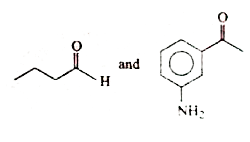Sodium extract of an organic compound gives blood red colour with FeCl3. It contains
not simple harmonic
simple harmonic with amplitude 0.2m
N a & S both
N or S
The correct Answer is:C
To solve the question, let's break it down step by step:
Step 1: Understanding the Reaction
The question states that the sodium extract of an organic compound gives a blood red color with FeCl₃ (ferric chloride). This indicates a specific reaction is taking place.
Step 2: Identifying the Key Compound
The blood red color observed in the presence of FeCl₃ suggests the formation of a complex. One well-known reaction that produces a blood red color involves thiocyanate ions (SCN⁻).
Step 3: Sodium Thiocyanate
The sodium extract likely contains sodium thiocyanate (NaSCN). When NaSCN is dissolved in water, it dissociates into sodium ions (Na⁺) and thiocyanate ions (SCN⁻).
Step 4: Reaction with Ferric Chloride
When thiocyanate ions (SCN⁻) react with ferric ions (Fe³⁺) from FeCl₃, they form a complex known as ferric thiocyanate (Fe(SCN)²⁺). The reaction can be represented as:
Fe3++SCN−→Fe(SCN)2+
This complex is responsible for the blood red color observed in the solution.
Step 5: Conclusion on the Composition
Since the sodium extract contains NaSCN, we can conclude that the organic compound must contain:
- Sodium (Na)
- Sulfur (S)
- Carbon (C)
- Nitrogen (N)
Thus, the answer to the question is that the sodium extract contains nitrogen and sulfur.
Final Answer
The sodium extract of the organic compound contains nitrogen and sulfur.
---
The question states that the sodium extract of an organic compound gives a blood red color with FeCl₃ (ferric chloride). This indicates a specific reaction is taking place.
The blood red color observed in the presence of FeCl₃ suggests the formation of a complex. One well-known reaction that produces a blood red color involves thiocyanate ions (SCN⁻).
The sodium extract likely contains sodium thiocyanate (NaSCN). When NaSCN is dissolved in water, it dissociates into sodium ions (Na⁺) and thiocyanate ions (SCN⁻).
When thiocyanate ions (SCN⁻) react with ferric ions (Fe³⁺) from FeCl₃, they form a complex known as ferric thiocyanate (Fe(SCN)²⁺). The reaction can be represented as:
Fe3++SCN−→Fe(SCN)2+
This complex is responsible for the blood red color observed in the solution.
Since the sodium extract contains NaSCN, we can conclude that the organic compound must contain:
- Sodium (Na)
- Sulfur (S)
- Carbon (C)
- Nitrogen (N)
The sodium extract of the organic compound contains nitrogen and sulfur.
Similar Questions
In the Lassaigne's test, one of the organic compound X gives blood red colour with FeCl3. Compound X, when fused with sodium metal forms compound Y. Molecular mass of compound Y is
View SolutionIn the Lassaigne's test , one of the organic compound gave red colour with FeCl3.Ccompound can be:
View Solution
Knowledge Check
A mixture of two organic compound gives red coloured precipitate with cuprous chloride and silver mirror on heating with Zn and NH4Cl followed by AgNO3+NH4OH solution. The mixture contains :
A B
B C
C D
D

The compound responsible for red colour is
View SolutionThe sodium extract of an organic compound on treatment with FeSO4 solution, FeCl3 and HCl gives red solution. The red colour of
View SolutionMethyl orange gives red colour in
View SolutionThe sodium extract of an organic compound on acidified with acetic acid and addition of lead acetate solution gives a back precipitate.
The organic compound contains :
View SolutionWhich of the following compound gives red colour with iodine solution ?
View SolutionWhich of the following is ( are ) correct for the sodium fusion extract of an organic compound both nitrogen and sulphur, carried out with excess of sodium ?
View SolutionWhich of the following compound will give blood red colour while doing the Lassaigne's test:
View Solution
